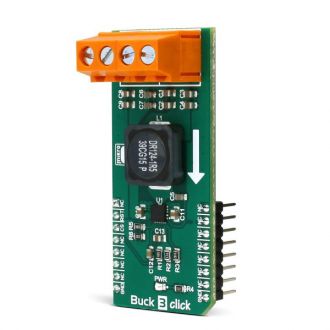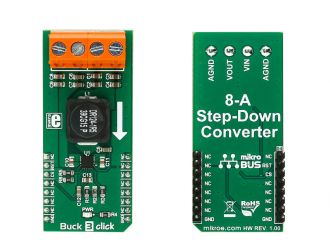
We strongly encourage users to use Package manager for sharing their code on Libstock website, because it boosts your efficiency and leaves the end user with no room for error. [more info]

Rating:
Author: MIKROE
Last Updated: 2018-04-04
Package Version: 1.0.0.0
mikroSDK Library: 1.0.0.0
Category: Buck
Downloaded: 4095 times
Not followed.
License: MIT license
Buck 3 click is a very advanced synchronous step-down (buck) converter, which is designed to deliver noise and ripple-free voltage to highly sensitive applications, such as FPGA and high-performance DSP platforms.
Do you want to subscribe in order to receive notifications regarding "Buck 3 Click" changes.
Do you want to unsubscribe in order to stop receiving notifications regarding "Buck 3 Click" changes.
Do you want to report abuse regarding "Buck 3 Click".


Library Description
The library carries only two functions needed to control Buck 3 click.
Key functions:
Examples Description
The demo application is composed of three sections:
Note: Open Drain Power Good Indicator, it is asserted low if the output voltage is out of PGOOD threshold, Overvoltage or if the device is under thermal shutdown, EN shutdown or during soft start. Once the FB pin voltage is between 93% and 107% of the internal reference voltage (VREF) the PGOOD is pulled high.
void applicationTask()
{
statePG = buck3_getState();
if (statePG == 0)
{
mikrobus_logWrite( "Overvoltage or thermal shutdown detected", _LOG_LINE );
Delay_1sec();
}
}
Other MikroElektronika libraries used in the example:
Additional notes and information
Depending on the development board you are using, you may need USB UART click, USB UART 2 click or RS232 click to connect to your PC, for development systems with no UART to USB interface available on the board. The terminal available in all MikroElektronika compilers, or any other terminal application of your choice, can be used to read the message.